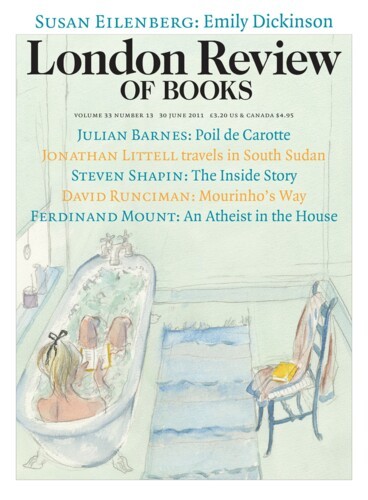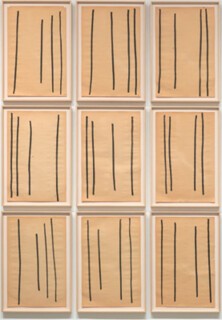My wife had never been to New York before, so we decided we’d walk to the Met from Grand Central Station. On Fifth Avenue, just near Rockefeller Centre, we stopped to watch some roadworks: a guy in a front-end loader was laying down a line of inch-thick, six-foot-long steel plates. He would pick up a stack of half a dozen in his bucket, then reverse while raising the lift arms, so that the rectangles fell neatly end to end. It was balletic; it was a card trick; it was industrial. It was totally Richard Serra.
The artist wouldn’t thank me for the analogy. Analogy isn’t Serra’s thing. But as a foreigner, you can’t visit America and not see the forms and the textures and the dynamics of the Serraverse everywhere you look: in the serial squares of boarded-up factory windows; in the blank, black silhouettes of rooftop billboards; in the rusty plates on the sticky black tarmac; even in oversize Fifth Avenue shop windows and flat-screen TVs. Why is it that sculpture with such a powerful vernacular-industrial resonance is so often discussed in terms of the Sublime?
At the start of Richard Serra Drawing (until 28 August) there are four performance videos from 1968. It is a witty bit of curating, in that each work, while dealing with fundamental structural materials and actions, also seems to allude to drawing in some way. In Hands Tied, the knotted string from which the artist’s hands struggle to escape is the punitive opposite of Paul Klee’s bouncy, cheerful ‘taking a line for a walk’. In Hand Lead Fulcrum the artist’s arm drops slowly down off the horizontal, neatly allegorising the weight of pigment, while also articulating the physical labour of the drafting hand. The two pairs of hands in Hands Scraping (one Serra’s, the other belonging to his sometime performance collaborator Philip Glass) are drawing in reverse: shovelling, sweeping, picking and wiping up a heap of steel filings. And in Hand Catching Lead, the blackened artist’s fingers snatching at falling shards of metal are at once drawing’s tool and the surface drawn on.
The endurance-trial aspect of these performances, in which manual labour is reified and refined as cultural product, is a consistent feature of Serra’s art, and is seen most clearly in this exhibition in the 30-odd black paintstick drawings dating from 1973 to 2010. The first of these heavily worked, concrete abstracts is a startling untitled work, a vertiginous trapezium of greasy shadow, edged with a pitted, pebbly strand where masking tape has been pulled off the paper. After this the drawings soon settle into a more rectilinear and symmetrical, more nine-to-five pattern, some on paper, many on canvas, all covered with – or rather consisting in – a rich, fat, deep, serious, oily, coaly, steely black.
The surfaces are quite extraordinary. In some, the paintstick has an organic smoothness, like that of a combed animal pelt, or a hairy tweed, or like the squeegee drag and blur found in Gerhard Richter’s abstract canvases. Others are thickly granulated, pitted and bubbled like roughly screeded concrete or rust-encrusted steel. In a few, the artist has heated the paintstick until it becomes almost viscous, and has really loaded up the paper, enlivening the resulting sugary black morass with faint traces of bootprints, or teasing it up into relief maps, reptile skin, leaves.
These big black fields command attention and respect simply by virtue of their grand materiality – Serra thinks that blackness is ‘a property, not a quality’. That insistent materiality encompasses not only surface, but also shape and scale and position. Serra knows that a triangle has less ‘weight’, less visual-experiential substance than a diamond, which in turn has less than a rectangle. He knows that a vertical rectangle has less than a horizontal, and demonstrates the fact with an engineer’s precision in Elevational Weights: Weight for Weight I and II. Here two sheets of paper – the same size, but one vertical and the other horizontal – are both covered in paintstick, save for a matching narrow horizon at the top of each. Though the vertical drawing has more square inches of blackness, it is the horizontal which gives the greater sense of mass, of stasis.
As with weight, so with form; in other works Serra messes with the set square in your head. Abstract Slavery is a vast nine by 18-foot canvas, a work as heroic, as physically demanding in its facture as its (studio joke) title implies. But it is off square. As soon as your eyes register the irritant, the discrepancy between the horizontal of the floor and the rising bottom edge of the drawing, you are immediately pulled into the life of the work, into an engagement with its materiality. In a group of works from 1989 – the year Serra’s great New York public sculpture Tilted Arc was destroyed – paired squarish black blocks crash against each other or split apart, leaving a narrow but clear faultline, which is at once geometrical, formal, geological and political.
Serra’s drawings are not pure, perfect, self-sufficient, suprematist or minimalist forms; they are built things. They need a bit of packing here, a bit of bog there; they need the viewer to act on them. The earliest work in the exhibition is the text drawing Verb List (1967-68), a lexicon of more than a hundred artistic acts arranged in four columns on two sheets of paper: ‘to collect’, ‘to cut’, ‘to curve’, ‘to encircle’, ‘to disarrange’ and so forth. But as you go down the rows the preposition shifts from ‘to’ to ‘of’, and the verbs become gerunds: ‘of grouping’, ‘of layering’, ‘of reflection’. And some of the words have no active element at all, are not verbs but nouns, both abstract (gravity, entropy) and concrete (waves, tides, nature). The ambiguity or inconsistency of Verb List, the way it segues subtly between doing and being, highlights the way the later, larger drawings work. They require the viewer to create or define the perceptual-architectural space which is the primary condition of their existence.
Serra’s implicit instruction is to approach his surfaces, to move in. As you get closer to that dense weave of paintstick, the outer world begins to recede from your field of vision. The form and texture of the drawing assume absolute priority. When a work has two elements, the trap springs even faster. Where two rectangles meet at right angles, the centre of gravity is inescapably that corner. Where the rectangles sit opposite each other, as in Blank and Union, you are immediately caught between the two as between magnetic poles, pinned between the extremities of your peripheral vision. You are pulled into Serra’s reality, into a physical experience of the thing in itself.
In Edmund Burke’s definition of the Sublime, ‘the mind is so entirely filled with its object, that it cannot entertain any other, nor by consequence reason on that object which employs it.’ When you get up close to these drawings, they create just such an experience of formlessness, or rather, to use Kant’s term, of ‘boundlessness’ (Grenzenlosigkeit). I think this is what Serra means when he speaks of the ‘openness’ of a work. It is a classic post-minimalist paradox. Your response, your action creates the conditions for the experience of sublimity. Yet faced with the grandeur of the Sublime you can no longer think, let alone act, only be.
Because of the intensity of engagement demanded by these works, because they are – at least momentarily – the whole universe, as you pull back, you become all the more aware of what is around them: the perforated acoustic ceiling tiles with their air-conditioning and lighting channels, showing their age in odd stains and watermarks; or the square granite blocks of the floor, bearing the scuffs and chips of millions of visitors and hundreds of shows. In making you so intensely conscious of your own perception, your own body, the work also draws your attention to the other people in the space: your wife in her red dress making an El Lissitzky accent against black slab and white wall; the museum guard humming quietly to himself; that couple of Scandinavian designer shoulder-bag guys, totally immobilised by the stereo eyephones of Blank; the Japanese man giggling at the black rising sun circle of Institutionalised Abstract Art.
It also makes you think about the artist. Despite Serra’s insistence on the drawings’ independence, their self-referentiality, their openness, this ostensible purity is cheerfully compromised in his titles, which allude to personally meaningful places, people and events. Pacific Judson Murphy is a reference to one of the steel mills where he worked as a young man to earn the money for college; Zadikians is a tribute to his then assistant Zadik Zadikian; The United States Government Destroys Art is an angry, blunt, polemical response to the Tilted Arc affair.
But don’t try to get too close. Make no mistake, Serra is a tough guy, a front-end-loader philosopher, a ‘don’t give a damn’ democrat. While he is happy to share his hard-labour, hard-nut ontological confidence, he doesn’t solicit your vote. Sublime indifference, that’s what it is.
Send Letters To:
The Editor
London Review of Books,
28 Little Russell Street
London, WC1A 2HN
letters@lrb.co.uk
Please include name, address, and a telephone number.


